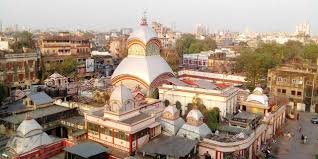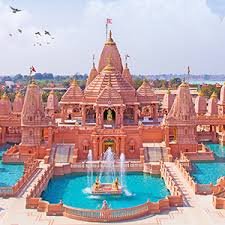Nestled in the heart of Kolkata, the Kalighat Kali Temple is one of the most revered Shakti Peethas in India. This ancient temple, dedicated to Goddess Kali, attracts millions of devotees every year, offering them a spiritual refuge and divine blessings. Read more about Kalighat Kali Temple Kolkata.
Kalighat Kali Temple Kolkata is not just a place of worship; it is a symbol of faith, history, and cultural richness. Believed to be over 1,000 years old, this temple holds a unique position in Hindu mythology and continues to inspire devotion and spirituality.
Join us as we explore the history, spiritual significance, rituals, and architectural beauty of this powerful temple.
The Legend Behind Kalighat Kali Temple
The Mythological Connection
According to legend, when Sati self-immolated in grief over her father’s insult to Shiva, the grief-stricken Lord Shiva carried her body across the universe. To restore cosmic balance, Lord Vishnu cut her body into pieces with his Sudarshana Chakra.
It is believed that Sati’s right toe fell at Kalighat, making it one of the most powerful Shakti Peethas. This divine connection makes the temple a focal point of worship for devotees seeking protection, blessings, and liberation from suffering.
The History of Kalighat Kali Temple
An Ancient Shrine with a Glorious Past
The Kalighat Kali Temple has a long and fascinating history. The earliest records of the temple date back to the 15th century, but historians believe that the original temple existed much earlier as a simple hut.
The current structure of the temple was built in 1809 by Sabarna Roy Chowdhury, a wealthy zamindar family of Bengal. Over time, the temple has undergone multiple renovations, but its spiritual energy and sacred essence remain untouched.
Spiritual Significance: The Power of Maa Kali
The Fearsome and Benevolent Goddess
The presiding deity of Kalighat is Goddess Kali, worshipped here as Maa Kalika or Dakshina Kali. Unlike traditional idols, the image of Kali in Kalighat is unique.
The idol is made of black stone and features three huge eyes, a long golden tongue, and four hands holding weapons and blessings.
Instead of being sculpted, the idol is adorned with gold jewelry and a silver tongue, making it appear lifelike and powerful.
The deity represents both destruction and protection, reminding devotees that she removes negativity while granting divine wisdom.
Devotees believe that praying at Kalighat grants immense spiritual power, success, and liberation from troubles. Many come here to seek blessings for health, prosperity, and relief from hardships.
Architectural Beauty of Kalighat Temple
A Blend of Tradition and Devotion
The Kalighat Kali Temple stands as a magnificent example of Bengali temple architecture.
🏛 Natmandir (Prayer Hall) – A large covered space where devotees gather for worship and aarti. The sound of conch shells and temple bells adds to the spiritual atmosphere.
🏛 Shoshti Tala – A small shrine dedicated to Sitala Devi, the goddess of healing.
🏛 Harkath Tala – The sacrificial altar where traditional Bali (animal sacrifice) is performed. While some animal sacrifices still occur, many devotees offer vegetarian sacrifices like pumpkins and sugarcane.
🏛 Radha-Krishna Temple – A beautiful shrine dedicated to Lord Krishna and Radha, showcasing the inclusivity of Hindu worship at Kalighat.
Every corner of the temple radiates spiritual energy, making Kalighat not just a place of worship but a divine experience.
Daily Rituals and Festivals at Kalighat
Rituals That Strengthen Devotion
The Kalighat Kali Temple follows a strict worship schedule, with each ritual aimed at strengthening the bond between devotees and Maa Kali.
Mangala Aarti (4:00 AM) – The temple doors open with a grand morning aarti, awakening the divine mother.
Bhog Offering (12:00 PM) – Devotees offer rice, lentils, vegetables, and sweets as prasad.
Sandhya Aarti (7:00 PM) – The temple glows with lamps, incense, and devotional chants.
Grand Festivals at Kalighat
Kali Puja – The biggest celebration at Kalighat, where thousands of devotees offer prayers on Diwali night.
Durga Puja – The entire temple is decorated, and special aartis are conducted for ten days.
Poila Boishakh – The Bengali New Year, celebrated with cultural programs and special prayers.
During these festivals, the temple becomes a spectacle of devotion, lights, and spiritual ecstasy.
Why Visit Kalighat Kali Temple?
The Kalighat Kali Temple is not just a place of worship—it is a spiritual powerhouse. Here’s why you must visit.
Historical and Cultural Significance – Witness a temple that has stood for centuries, attracting devotees from all over India.
Feel the Vibrancy of Kolkata’s Spiritual Heart – Located in one of the oldest parts of the city, the temple lets you experience the real essence of Kolkata.
Receive Blessings of Maa Kali – Offer your prayers and seek the protection and guidance of the fearsome yet loving Goddess.
How to Reach Kalighat Kali Temple?
Air – The nearest airport is Netaji Subhas Chandra Bose International Airport (Kolkata Airport), 25 km away.
Rail – The closest railway station is Sealdah Railway Station, 8 km away.
Metro – The Kalighat Metro Station is just 500 meters from the temple.
Road – You can take taxis, buses, or auto-rickshaws from anywhere in Kolkata to reach the temple.
Conclusion
The Kalighat Kali Temple is a sacred powerhouse of devotion, history, and spiritual energy. Whether you seek divine blessings, spiritual enlightenment, or cultural insights, this temple offers a transformative experience.
Visit Maa Kalika’s abode, immerse yourself in devotion, and feel the divine presence that has been guiding devotees for centuries.





